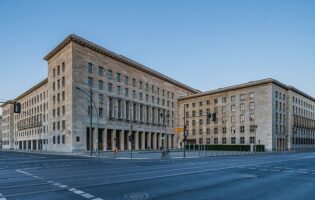
Tobias Nordhausen via Flickr
Opposition(s) in a Fragmented Party System

Barbara Donovan
Wesleyan College
Barbara Donovan is Professor of Political Science and Dupont Guerry Chair of History and Economics at Wesleyan College. She teaches courses in comparative and international politics. Her areas of specialization are German and European politics, democratization, regional integration, and immigration. She received her B.A. in International Relations from Tufts University, her M.A. from the University of London, and her Ph.D. from Georgetown University.
The politics of opposition in Germany are increasingly complicated. For much of the early history of the Federal Republic, the party system was a two-bloc affair, with one side in government, the other in opposition, and the Liberals (FDP) as kingmaker. The fragmentation of the party landscape and varying political strategies adopted by parties mean there are now in fact several oppositions (opposition with a plural S). This has implications for stability and governance and is especially relevant now that the governing coalition is more pluralistic than had been the norm, with three parties contributing to the government’s majority. Below I examine each of the parties currently in opposition, strategies they are pursuing, and likely implications for the political process.
The September 2021 Bundestag election landed four parties (three party families) in the opposition: The Left, the Christian Democratic Union, its ‘sister’ party the Christian Social Union, and the Alternative for Germany. The CDU/CSU, with a total of 197 seats (out of 736), moved into the opposition for the first time in sixteen years. The Left, represented in the Bundestag since 1990 when it was the Party of Democratic Socialism, did not meet the 5 percent threshold for parliamentary representation but won three direct mandates, and as a result, secured full proportional representation and 39 seats (down from 69 in the last parliament). The AfD, in parliament only for the second time, occupied 80 seats, down from the last session when with 94 MdBs it was the largest opposition party in the Bundestag. In a 2010 article in German Politics, Dan Hough describes 3 different types of opposition strategies: policy pusher, strategic opponent, and obstructionist. All three are evident among the current oppositions.
The CDU/CSU
Forcing the CDU and CSU into opposition were some of the worst electoral results the parties had ever endured. The deep losses were attributed to the so-called ‘Merkel voter’ going elsewhere, and indeed, the parties lost heavily to the SPD, Greens, and FDP, but issues went beyond the popular incumbent no longer running for office. In the case of the CDU, it was a party which after sixteen years in power needed new faces, new ideas, and a new identity. But renewal involves dilemmas. Given the support for Angela Merkel among centrist voters, there are risks in moving farther to the right. But, if the party does not move right, it risks giving up ground to the AfD. There are also specific challenges in the eastern states where the CDU lost heavily to the AfD and in Bavaria, where the CSU gave up votes to the AfD and the Freie Wähler. The parties face internal divides between different membership constituencies, and between members and voters, with the membership being older and more male than the general population. There are few women in the leadership pipeline, and the party leadership continues to delay a vote on gender quotas. The CDU’s membership chose Friedrich Merz as the new party chair, and with the selection of a pro-business conservative, the party signaled a move to the right. Merz, however, was quick to distance himself from the AfD, even its more moderate wing. The new party leader, who was also named chair of the Bundestag caucus, moved to repair relations with the CSU after the damage from the leadership contest between Armin Laschet and Markus Söder in the spring of 2021.
In the Bundestag, the CDU/CSU strategy is that of strategic opposition, with a view to assuming a governing role again, securing wins in upcoming state elections, and reclaiming voters in the east. Such a strategy is made difficult by the Russia-Ukraine war. It is a challenge to stage opposition during a time of crisis—there is pressure to ‘rally around the flag’—but the CDU/CSU also shares responsibility with the SPD for policy on Russia during past decades. Moreover, whereas the CDU/CSU has traditionally been the party for a strong defense, since Olaf Scholz’s Zeitenwende, the coalition government has assumed that mantle. On many major issues, such as energy policy and relations with NATO and EU allies, the CDU/CSU’s positions are not different from those of the government. Although Merz angles for the role of strategic opponent, the Russia/Ukraine crisis and divisions within his own party have meant the party has had to resort to more of a role of policy pusher.
Die Linke
On the far left, The Left experienced its worst electoral result since 2002. The party’s losses were overwhelming due to the declining position of the party in the east, where its vote share had been dropping for several years, with many voters moving to the AfD. Coming out of the elections, the party appeared set to continue the serious infighting that had come to characterize the party. There are deep internal divisions within the party, between urban and rural constituencies, and between more educated professional classes and an industrial working class. In April, one of the co-chairs of the party resigned amid charges of sexual harassment within party ranks. The other chair countered she would continue to lead alone, but many voices within the party called for new leadership all around. There is a dire need for renewal, but it is not clear what direction it will come from. This affects the party’s opposition role. The party has a long history of obstructionist policies, staging a ‘far-left’ opposition especially when the SPD was in power during the Red-Green and Grand Coalitions. Its role was also shaped by the fact that other parties did not recognize it as regierungsfähig (fit to govern). However, of late, The Left has barely been perceptible as opposition. Speculations abound about whether the party has reached a threshold of irrelevance. It was not helped in its profiling by the fact that during the COVID-19 pandemic, the party, along with other members of the opposition with exception of the AfD, assumed a cooperative position. Russia’s aggression in Ukraine further tarnished the reputation of the party and undermined its credibility, given its pro-Russian sensibilities. In terms of parliamentary strategy, The Left aims at an obstructionist role but without apparent impact.
The AfD
The AfD lost about 20 percent of its voters between 2017 and 2021, but its base—considered to be about 10 percent of the German electorate—stayed loyal. It performed strongly in the eastern states where the party averaged almost 20 percent and was the second strongest party overall following the SPD. The election result precipitated a decisive round of infighting within the party, with moderate Jörg Meuthen leaving the party in January, citing its “totalitarian character.” The fallout of the internal party divides left Tino Chrupalla and Alice Weidel—who had been the party’s top candidates in the campaign and were then named party leaders and caucus leaders in late fall—and other members of the radical, populist, and nativist wing firmly in change. During its first term in the Bundestag, the AfD earned the obstructionist label, and one of the criticisms from the moderate elements in the party was that it needed to act as a “professional” party interested in assuming responsibility and governing. The party heads into its second legislative term continuing to act as “fundamental opposition” with a goal of delegitimizing the established political system. The AfD style is purely performative. Its behavior on the floor of the Bundestag is intentionally aggressive—full of harsh language, interruptions, and provocations (including purposeful mask violations)—with the aim of challenging convention and obstructing process. Its behavior only reinforced its political isolation. Other parties have not moved in the direction of AfD rhetoric or policy and have essentially evoked a cordon sanitaire around the party. On issues, the AfD has shown itself to be fairly agile (if not at attracting new voters, at least it can hold on to its base). Issues such as EU membership and immigration are less salient than in the AfD’s early years, but with COVID-19, the party quickly appropriated the COVID-skeptic, anti-lockdown, and anti-vax mantle and more recently lined up to take advantage of inflationary pressures and issues around energy security and fuel prices. Its pro-Russia position does not help the party’s reputation but party leaders continue to criticize the coalition government for its support of Ukraine.
Germany’s opposition is indeed a fragmented one, but while opposition parties cover the entire political spectrum from left to right, it is only the CDU/CSU that presents itself as a strategic opponent to the governing coalition. Centrifugal forces, either to the far left or far right, are largely non-existent as a result of the Left’s and the AfD’s internal weaknesses, obstructionist tactics, and political isolation at the national level. In short, while fragmented, there is still a strong centrist dynamic to the parliamentary system. Political opportunity structures will shape the degree to which the CDU/CSU can assume political advantage. At present, the Russia-Ukraine crisis presents considerable challenges. It remains to be seen how adept Merz is at maneuvering the CDU/CSU through these unprecedented political times.








